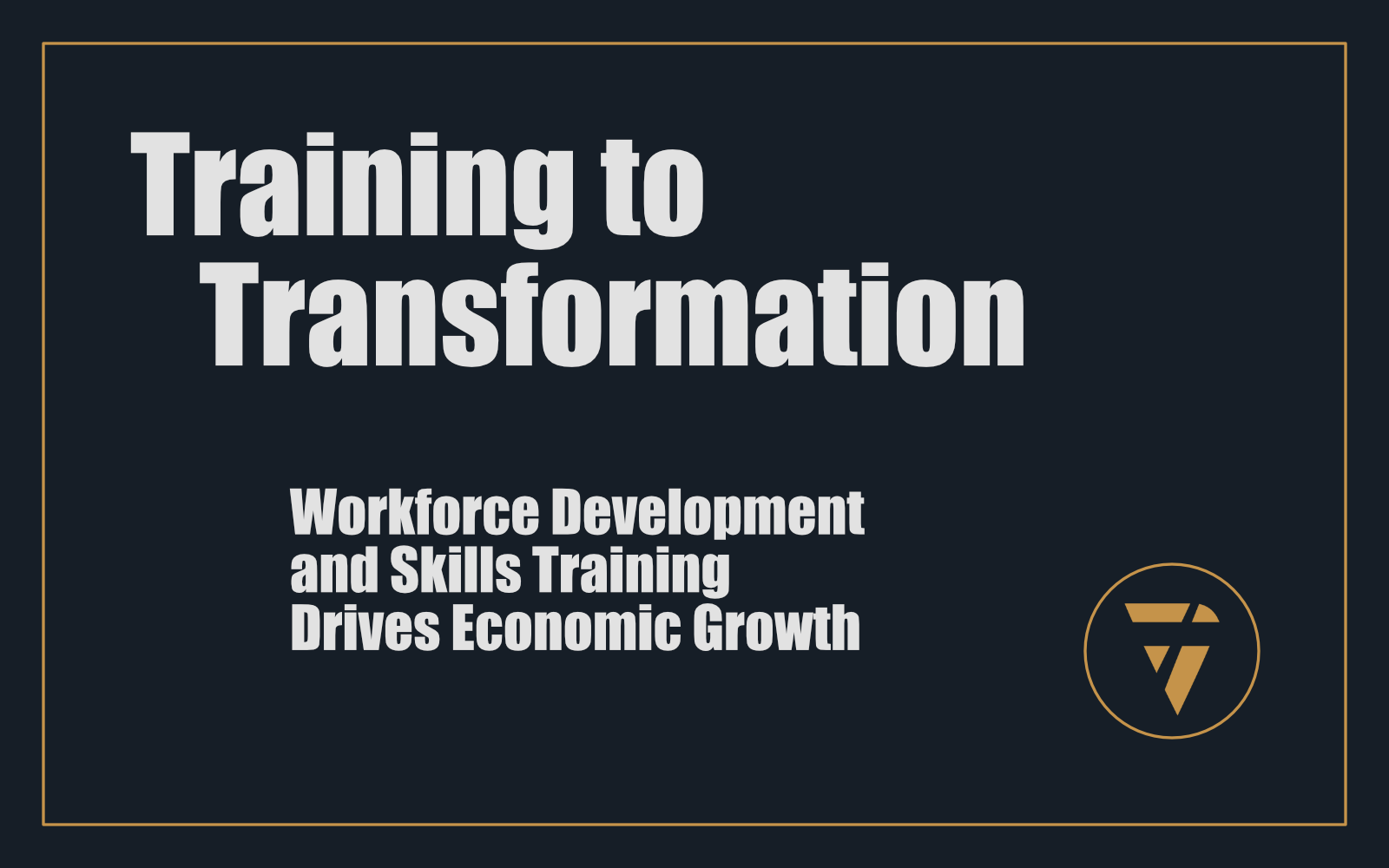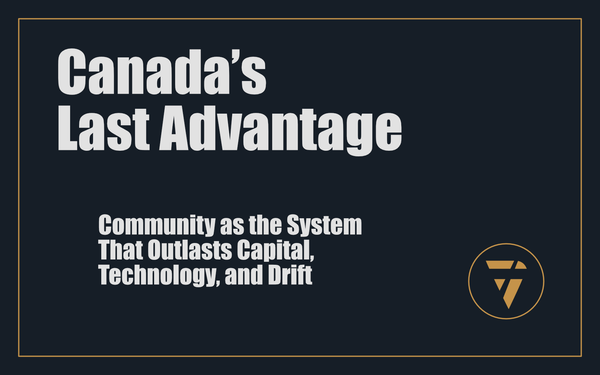Training to Transformation

Workforce Development and Skills Training Drives Economic Growth
A strong economy is not built on infrastructure alone. Roads, utilities, and digital connectivity may create the conditions for growth, but without a skilled and capable workforce, businesses cannot expand, industries cannot innovate, and communities cannot sustain long-term economic success.
Workforce development is the most overlooked yet most critical factor in economic revitalization. In small towns, rural areas, and underserved communities, the lack of targeted training programs and employment pathways leads to chronic underemployment, stagnant wages, and declining business competitiveness. Meanwhile, industries struggle to find workers with the right skills, forcing them to either downsize or relocate to areas with better labour markets.
The solution is a strategic workforce development model that aligns local talent with industry needs, creates sustainable employment pathways, and fosters investment in human capital.
1. The Link Between Workforce Training and Economic Revitalization
Economic development is often framed as a process of attracting businesses, securing investment, and building infrastructure. However, without a trained workforce, these efforts are meaningless.
A strong workforce doesn't just fill existing jobs, it attracts new businesses, encourages entrepreneurship, and drives long-term economic sustainability. The ability of a community to provide a reliable, skilled labour pool directly influences business investment decisions.
How Workforce Development Drives Economic Growth
- Attracting and Retaining Businesses
- Companies looking to relocate or expand prioritize regions with skilled and adaptable workforces.
- Without access to trained employees, businesses face higher operational costs, longer hiring cycles, and reduced productivity.
- Increasing Wages and Economic Mobility
- Workers with specialized skills command higher wages, improving overall economic conditions.
- Higher wages lead to greater consumer spending, stronger local businesses, and increased tax revenues.
- Reducing Unemployment and Underemployment
- Many job seekers in small communities lack industry-specific training. Workforce development programs bridge this gap, providing practical skills that match real job openings.
- Encouraging Entrepreneurship and Innovation
- When workers gain specialized knowledge, they are more likely to start their own businesses, create new technologies, and contribute to regional innovation.
- Future-Proofing the Economy
- As industries evolve, workforce development ensures that employees remain adaptable, preventing long-term economic stagnation.
Despite these clear benefits, many communities fail to invest in workforce training, leaving businesses and job seekers disconnected. The challenge lies in creating structured employment pathways that ensure workers can access the skills they need to succeed.
2. How to Create Employment Pathways in Small Communities
Many workforce training initiatives fail because they do not align with real-world industry needs. In smaller communities, the challenge is even greater—local economies often depend on a few dominant industries, making it difficult to build diversified, future-ready employment opportunities.
A successful workforce development model must include:
1. Industry-Aligned Training Programs
- Training must be designed in partnership with employers to ensure it meets industry standards.
- Programs should be based on current and emerging job market trends, not outdated models.
- Certifications and skill development must be recognized by local and regional employers.
2. Apprenticeships and Hands-On Learning Opportunities
- Traditional classroom learning is not enough. On-the-job training, internships, and apprenticeships create direct employment pathways.
- Businesses should be encouraged to hire trainees and invest in mentorship programs.
3. Accessible and Flexible Training Options
- Many small-town workers cannot afford to leave their jobs for full-time training programs. Workforce initiatives must offer:
- Part-time and online learning options.
- Financial support for job-seekers in transition.
- Employer-sponsored upskilling programs.
4. Support for High-Growth Industries
- Communities must identify key industries with strong long-term potential and train workers accordingly. This could include:
- Renewable energy and sustainability sectors.
- Advanced manufacturing and automation.
- Digital services, e-commerce, and remote work industries.
5. Regional Workforce Collaboration
- Many small communities cannot support full-scale training initiatives on their own. Regional partnerships between municipalities, colleges, and private sector players create stronger, more comprehensive workforce programs.
A well-designed workforce development system ensures that every job seeker has access to training that leads directly to employment. However, these programs require funding, infrastructure, and corporate engagement to be truly effective.
3. The Role of Corporate Sponsors in Funding and Supporting Training Programs
While governments play a key role in workforce development, corporate sponsorship and private sector involvement are essential for long-term success. Businesses have a direct stake in workforce quality, and by investing in training programs, they secure their own future talent pipeline.
How Businesses Benefit from Workforce Development Investment
- Reduces Hiring Costs and Talent Shortages
- A well-trained workforce means lower recruitment costs, reduced turnover, and faster onboarding.
- Increases Productivity and Innovation
- Employees who receive ongoing skills training are more efficient, adaptable, and innovative.
- Improves Employee Retention and Job Satisfaction
- Workers who receive training and career development opportunities are more likely to stay with their employers long-term.
- Enhances Corporate Reputation and Community Engagement
- Companies that invest in workforce training build stronger relationships with local governments, job seekers, and community organizations.
Ways Corporations Can Support Workforce Training
- Sponsoring Industry-Specific Training Programs
- Businesses can fund technical training initiatives, certification programs, and apprenticeships in their industry.
- Creating Employer-Led Training Centres
- Larger corporations can develop in-house training centres, providing local workers with direct access to job-specific education.
- Providing Tuition Assistance and Upskilling Grants
- Offering employees financial support for continuing education ensures ongoing workforce development.
- Partnering with Community Colleges and Vocational Schools
- Joint programs between businesses and educational institutions create seamless employment pathways.
Workforce Development is Economic Development
No community can achieve real, lasting economic success without an investment in human capital. Workforce development and skills training are not optional, they are foundational to long-term prosperity.
Small towns and underserved regions often struggle to compete with urban centres for business investment. However, a well-trained, highly skilled workforce changes that equation. Communities that invest in employment pathways, industry-aligned training, and corporate partnerships position themselves as prime locations for business expansion, entrepreneurship, and sustainable economic growth.
Manitou Economic Development Agency (MEDA) recognizes that economic revitalization starts with people. Through targeted training initiatives, industry partnerships, and strategic workforce programs, MEDA is ensuring that communities have the talent they need to thrive.
The future belongs to those who invest in skills, create opportunities, and build stronger workforces. The only question is—who is ready to lead?
This is what I’m working on. Tell me what you think, I enjoy the conversation! Subscribe and follow the work in real time.
Thanks!
B

A strong economy starts with a skilled workforce. Without training and employment pathways, businesses stagnate and communities shrink. The solution? Invest in people, build talent, and create opportunities. Who’s ready to grow the future?
PS -






